Among the most intriguing tarsier facts is that it is one of the smallest primates and the only wholly carnivorous primate alive. Tarsiers lived in Asia, Europe, Africa, and North America but now only live on a few islands in Southeast Asia. It inhabits the dense forests of Southeast Asian countries like Malaysia, Indonesia, and the southern Philippines. These primates have huge eyes and strong hind legs that help them survive in the wild. Let’s find out more about these little primates.
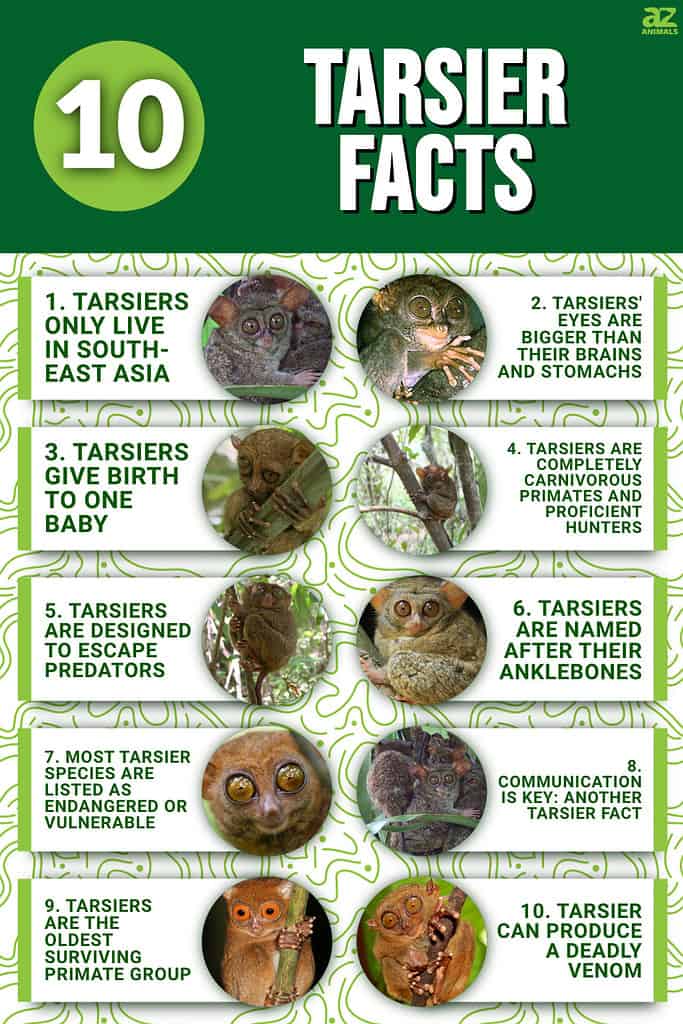
1. Tarsiers Only Live In South-East Asia

Tarsiers live on the islands of Malaysia, Indonesia, and the Southern Philippines.
Tarsiers live in lowland or mountain forests in Southeast Asian countries like Malaysia, Indonesia, and the southern Philippines. They commonly inhabit islands like Borneo, Sumatra, Bangka, Belitung, and Kalimantan. Moreover, other tarsier facts include 18 different subspecies, divided into three groups: Western Tarsiers, Eastern Tarsiers, and Philippine Tarsiers.
Eastern Tarsiers live on Sulawesi and the surrounding islands and spread themselves across different levels of the forests. The only Eastern Tarsier that is not as adaptable as the other Eastern Tarsiers is the Pygmy Tarsier. This tarsier only lives in the high mountainous forest area. Philippine Tarsiers live in lowland forests and on islands in the Philippines like Bohol, Samar, Leyte, and Mindanao.
2. Tarsiers’ Eyes Are Bigger Than Their Brains and Stomachs
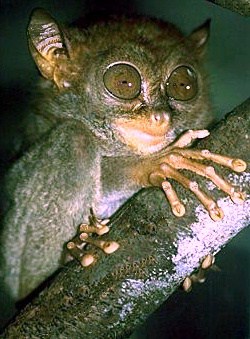
Tarsiers have huge alien-like eyes that help them hunt and spot predators in the dark.
Tarsiers have an alien-like appearance. These primates have huge eyes up to 16mm wide – a phenomenal tarsier fact. Also, their large eyes help them hunt and look for predators in the dark. Yet another fun fact about tarsiers is that they have flexible vertebrae. These vertebrae enable them to turn 180 degrees in both directions, similar to owls. They also have powerful hearing, thanks to their bat-like ears.
Different species have various physical features, but they all have small bodies, long tails, and fur covering their skin. This fur is incredibly soft and comes in grey, brown, or ochre. Other significant attributes include long hind legs, ensuring they can leap up to 16.4 feet or five meters. One more tarsier fact is their long fingers and toes with pads and nails at the tips, which help them to grip prey and branches.
3. Tarsiers Give Birth To One Baby
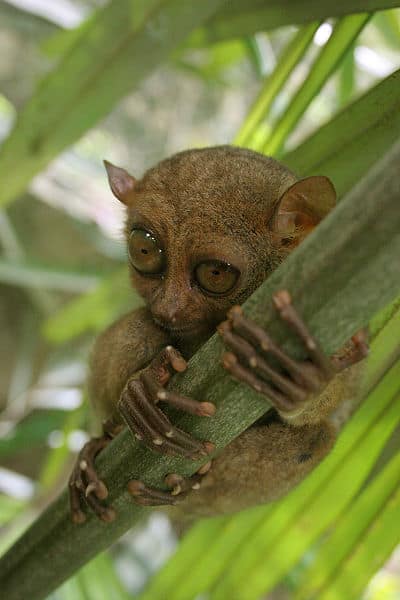
Philippine Tarsiers live up to 20 years, Western Tarsiers live for about 15 years, and Eastern Tarsiers reach an age of 12 years.
©Jasper Greek Golangco – Public Domain
True facts about the tarsier are that most species and subspecies breed all year round. The female is pregnant for six months before giving birth to a single baby. Although they are tiny, the baby is well developed at birth. Baby tarsiers also enter the world complete with a full coat of fur, open eyes, and, after a day old, can climb.
They nurse for two months, but some species start hunting when they are just one month. Baby tarsiers cling to their mothers as she climbs, but sometimes the mother will carry her baby in her mouth. Tarsiers reach sexual maturity when they are one to two years old and live long lives. Philippine Tarsiers have a lifespan of 20 years, Western Tarsiers live up to 15 years, and Eastern Tarsiers have a lifespan of 12 years.
4. Tarsiers Are Completely Carnivorous Primates and Proficient Hunters
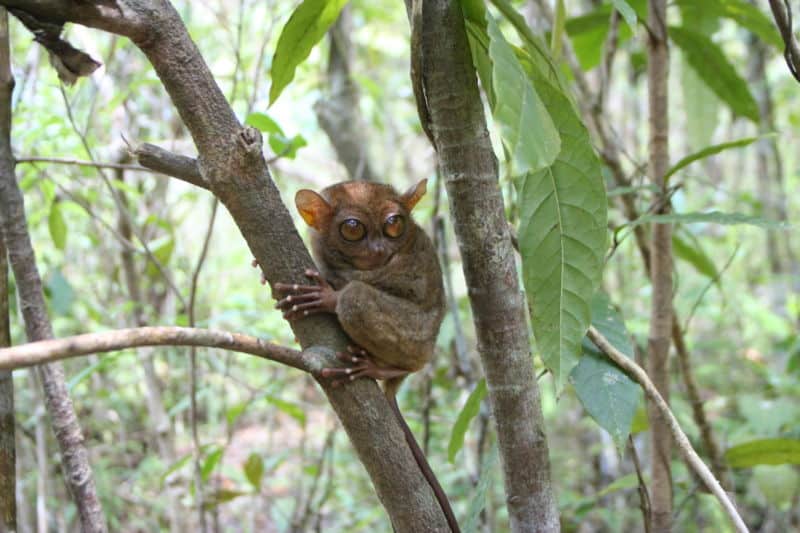
Tarsiers are skilled predators of frogs, lizards, small birds, and insects.
This tiny primate hunts at night and eats insects, frogs, lizards, and small birds. Some species of tarsier even eat poisonous snakes and bats. Tarsiers hunt by clinging to vertical branches and waiting for their prey. They will wait almost motionlessly for their quarry, only turning their heads to watch or listen for sounds. Once they identify their target, the tarsier moves closer before leaping towards and catching their meal. Tarsiers have long fingers and toes and can catch their prey in mid-air.
5. Tarsiers Are Designed To Escape Predators
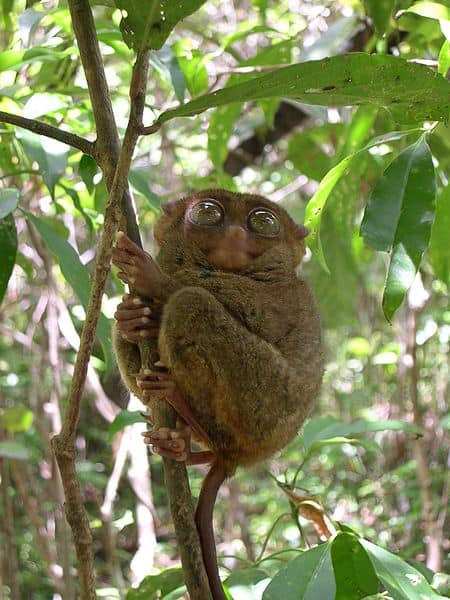
Tarsiers’ powerful hind legs are another tool that helps them leap significant distances in one movement to escape predators.
©Magalhaes – Public Domain
Because tarsiers are tiny, they are bite-sized snacks for predators like cats, birds of prey, snakes, and small carnivores. However, their large eyes allow them to see well in the dark, and their ears pick up the slightest noise. Tarsiers’ powerful hind legs are another tool that helps them leap significant distances in one movement to escape predators.
But, the tarsier’s main threat today is habitat loss. People are clearing large parts of their habitats for farming, mining, and grazing areas. Humans also illegally sell tarsiers on the exotic pet market, which remains a regrettable fact. Still, many die within a few days because of a lack of food or appropriate living conditions.
6. Tarsiers Are Named After Their Anklebones
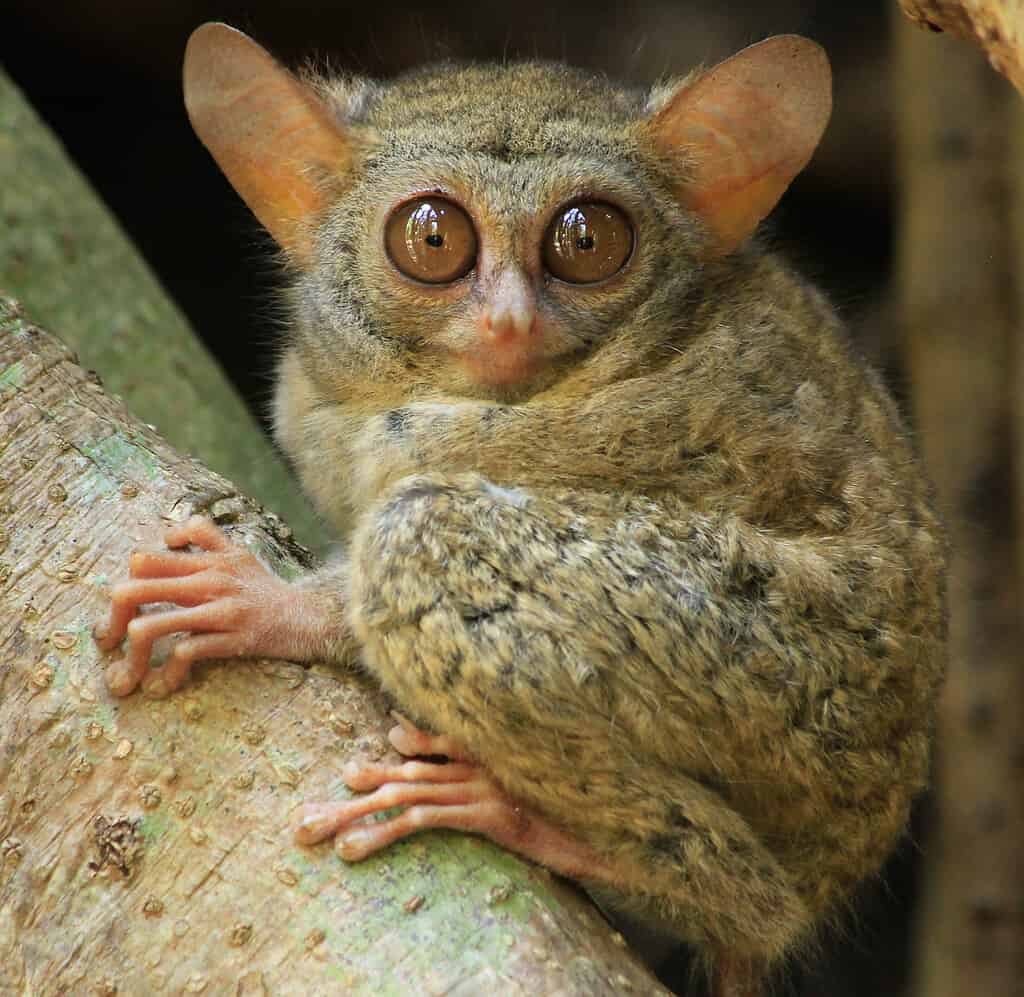
Their unusually long anklebones enable tarsiers to jump long distances.
©Meldy Tamenge / CC BY-SA 4.0 – License
Other tarsier fun facts are that they are named after their anklebones. These bones are unusually long in tarsiers. But these bones give them the power to jump distances 40 times their body’s length.
7. Most Tarsier Species Are Listed As Endangered Or Vulnerable

Only 50% of captured Tarsiers survive in their new homes, which makes captive conservation efforts difficult.
©iStock.com/nikpal
Tarsiers populations are declining. Some species, like the Siau Island Tarsier, are critically endangered, according to the IUCN. Other tarsier species are listed as Data Deficient by the IUCN because researchers cannot study them in the wild. However, conservation efforts are underway, explicitly targeting the Philippine Tarsier, but it has been difficult because of habitat loss. Only 50% of captured Tarsiers survive in their new homes, which makes captive conservation efforts difficult. This poor survival rate is often because of a lack of live food. Captive tarsiers also often have high infant mortality rates and slow reproduction rates.
8. Communication is Key: Another Tarsier Fact
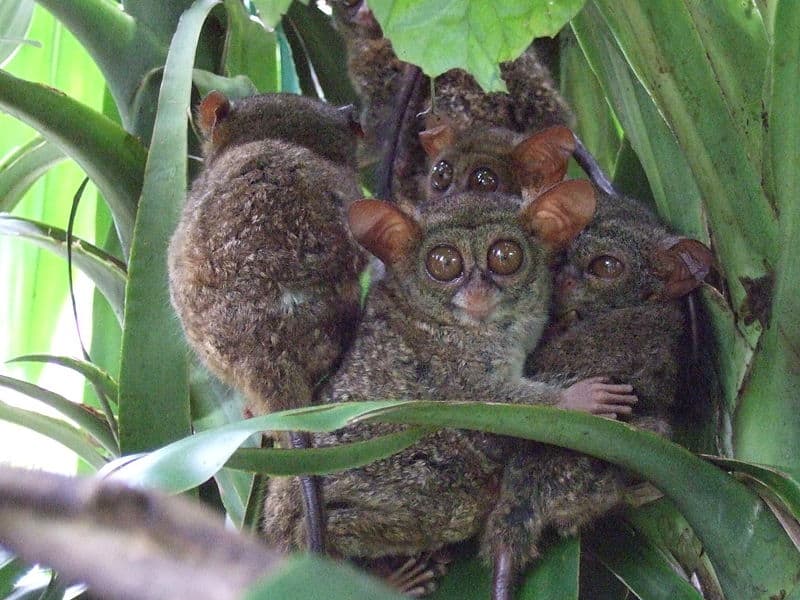
Tarsiers make 7 different communicative sounds and also use smell to communicate with each other.
These primates use seven different sounds to communicate. These sounds are a loud call, a smack whistle, a whistle, a chirp, a trill, a cheep, and a twitter. Tarsiers also use smell to communicate with each other. Male tarsiers mark their territory with urine, while females mark their mates by secreting a scent from a gland near their mouths.
9. Tarsiers Are the Oldest Surviving Primate Group

At least 55 million years old, the tarsier species used to inhabit Asia, Europe, North America, and
Africa
.
©Ryan M. Bolton/Shutterstock.com
The tarsier species is at least 55 million years old, and fossil evidence shows that they used to live in Asia, Europe, North America, and Africa. Tarsier fossils show that they were tiny, but their eyes suggest they were active during the day. They also did not have long hind legs or grasping feet like today’s tarsiers.
10. Tarsier Can Produce A Deadly Venom

If they feel threatened, the tarsier mixes the poison with their saliva, which becomes poisonous.
©iStock.com/Rachel Palmer-Goncalves
Tarsiers produce venom like some other Asian primates, such as slow lorises. They secrete a toxin from a gland in their arms or elbows. If they feel threatened, the tarsier mixes the poison with their saliva, which becomes poisonous. This poison causes an allergic reaction in predators. Female tarsiers also use this venom mix to cover their young for protection from predators. Scientists believe that their toxic bite and hissing is an evolved behavior that resulted from mimicking venomous snakes.
Up Next – Tiny Primates
- Tarsier vs Aye-Aye: What’s their Difference?
- Bush Baby
- Bush Baby vs Sugar Glider: 8 Important Differences
- The 10 Smallest Monkeys in the World
The photo featured at the top of this post is © iStock.com/Rachel Palmer-Goncalves
Sources
- Animal Facts Encyclopedia, Available here: https://www.animalfactsencyclopedia.com/Tarsier-facts.html
- Fact Animal, Available here: https://factanimal.com/tarsier/
- Treehugger, Available here: https://www.treehugger.com/tarsiers-cool-facts-about-these-wonderfully-weird-primates-4864006
- Springer Nature, Available here: https://link.springer.com/referenceworkentry/10.1007/978-94-007-6458-3_20
- Britannica, Available here: https://www.britannica.com/story/whats-the-difference-between-venomous-and-poisonous
- The New York Times, Available here: https://www.nytimes.com/2020/10/19/science/slow-loris-venom.html
- Smithsonian Magazine, Available here: https://www.smithsonianmag.com/smart-news/only-primate-toxic-bite-might-have-evolved-mimic-cobras-180952926/
- Kidadl, Available here: https://kidadl.com/facts/animals/tarsier-facts#:~:text=A%20Philippine%20tarsier%20is%20the,and%20fixed%20in%20one%20place.
Thank you for reading! Have some feedback for us? Contact the AZ Animals editorial team.






